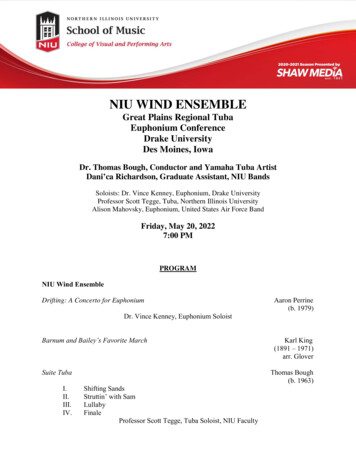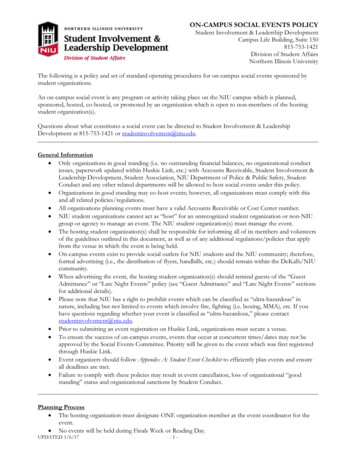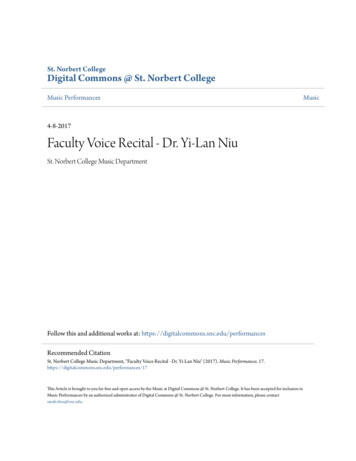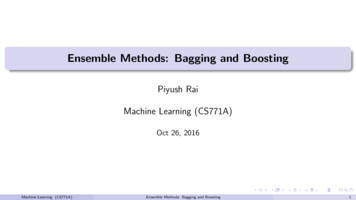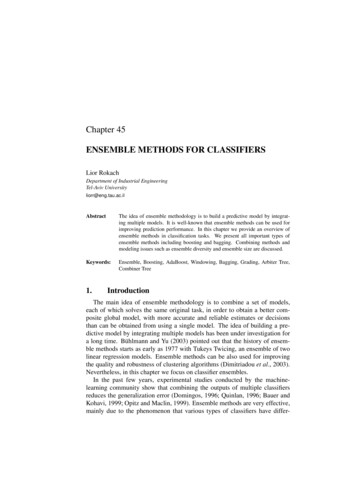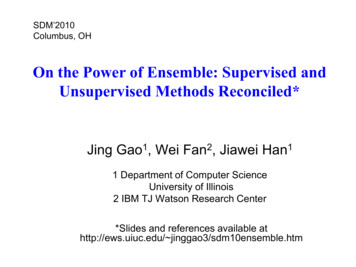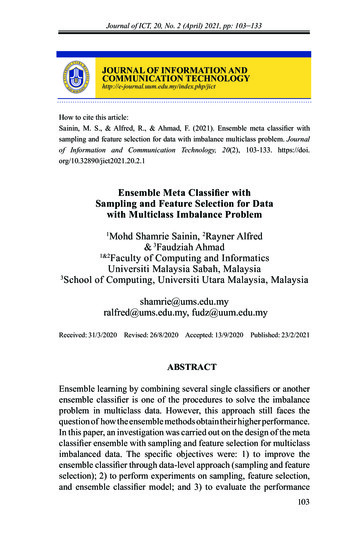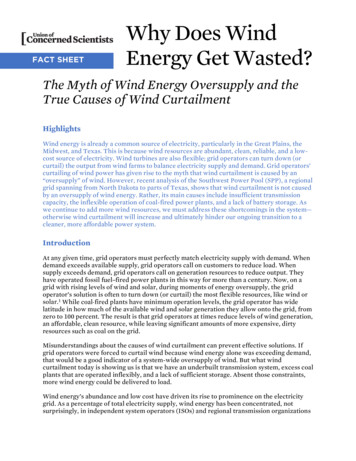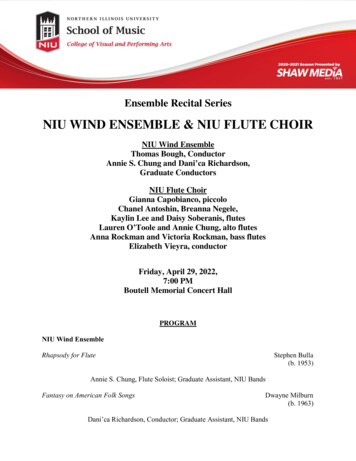
Transcription
Ensemble Recital SeriesNIU WIND ENSEMBLE & NIU FLUTE CHOIRNIU Wind EnsembleThomas Bough, ConductorAnnie S. Chung and Dani’ca Richardson,Graduate ConductorsNIU Flute ChoirGianna Capobianco, piccoloChanel Antoshin, Breanna Negele,Kaylin Lee and Daisy Soberanis, flutesLauren O’Toole and Annie Chung, alto flutesAnna Rockman and Victoria Rockman, bass flutesElizabeth Vieyra, conductorFriday, April 29, 2022,7:00 PMBoutell Memorial Concert HallPROGRAMNIU Wind EnsembleStephen Bulla(b. 1953)Rhapsody for FluteAnnie S. Chung, Flute Soloist; Graduate Assistant, NIU BandsFantasy on American Folk SongsDwayne Milburn(b. 1963)Dani’ca Richardson, Conductor; Graduate Assistant, NIU Bands
NIU Flute ChoirFirst Suite in Eb: ChaconneGustav Holst(1874-1934)arr. Michael BarreraNIU Wind EnsembleBarnum and Bailey’s Favorite MarchKarl King(1891 – 1971)arr. Glover-Intermission-Symphony No. 4David Maslanka(1943 – 2017)
PROGRAM NOTESRhapsody for FluteStephen Bulla began his musical instruction at age six, growing up in a musical household wherehis father played tuba and his mother played piano. He eventually graduated Magna Cum Laudefrom Berklee College of Music in Boston, where he studied trombone with Phil Wilson andComposition/Arranging with Herb Pomeroy.In 1980 he won an audition for the position of Staff Arranger to “The President's Own” UnitedStates Marine Band and Chamber Orchestra in Washington DC. For the next thirty years hewould provide musical scores for myriad White House events, beginning with the Reagan erauntil 2010.Working alongside film score legend John Williams he has transcribed music from “Star Wars”,“Catch Me If You Can”, and “Close Encounters of the Third Kind” for performances by theMarine Band with the composer conducting. Among many composer highlights was acommission from the Library of Congress to complete and orchestrate the last known manuscriptmarch of John Philip Sousa, titled The Library of Congress March. Another major project wascreated for the 50th anniversary of the Apollo 11 lunar landing. For this event he wascommissioned by the Brass Band of Huntsville (Alabama) to compose and conduct the premiereof the Von Braun Suite for band, narrator and NASA sourced video. On that occasion, held atthe U.S. Space & Rocket Center, all living lunar astronauts were in attendance.As a conductor, for fifteen years he directed the National Capital Band (Washington DC),producing several CDs and touring Australia, New Zealand, Russia, and Scandinavia with thatensemble. He later served for thirteen years as music director of New England Brass Band and ispresently music director for Brass Of The Potomac. As a frequent international band contestadjudicator, he received the President’s Award in 2015 from the North American Brass BandAssociation.Stephen Bulla is an active member of ASCAP (American Society of Composers, Authors, andPublishers) and has received that organization's Performance Award annually since 1984. Hispublished works can be found in the catalogs of Hal Leonard Music (USA and Europe), as wellas in The Salvation Army's music publication catalog (UK).His “Rhapsody for Flute” is divided into three sections. A fast-opening theme provides thesoloist with a rhythmic melody that evolves into a slower and more expressive middle section.Here, too, the band has ample opportunity to display a full, warm sensitivity with the music.This section concludes with a brief cadenza for solo flute supported by sustained woodwindharmony. The final section is quick and light-hearted, becoming an energetic finale to thisoriginal composition. Notes from the score and the composer’s website.
Fantasy on American Folk SongsDwayne Milburn (b. 1963) is a native of Baltimore, Maryland. Upon graduation he became theDirector of Cadet Music for the United States Military Academy at West Point. Among his manyduties, he served as the conductor for the internationally renowned West Point Glee Club,leading that group in performances at some of the finest concert halls in the county, includingCarnegie Hall, Myerson Hall, and the Kennedy Center. During his studies in Cleveland, hecontributed several arrangements to the Cleveland Orchestra.Mr. Milburn is active as a composer, conductor, and adjudicator. His choral and wind ensemblecompositions are published by Alfred, Ludwig Masters, and the Neil A. Kjos Music Company.In addition to his duties as Composer-in-Residence for the St. Matthew’s Music Guild, his workshave been performed by some of the finest collegiate and professional ensembles in the nation.-Notes from the score“The piece grew out of my desire to continue introducing young musicians and audiences to therich heritage of our American folk music tradition. The folk songs featured in this compositionare probably among the better known and I enjoyed the opportunity to see how they might speakto me, and in turn, how I might speak to the performers and audiences alike.”-Dwayne MilburnBarnum and Bailey’s Favorite MarchKarl King wrote “Barnum and Bailey’s Favorite” in 1913 just before joining the band as aeuphonium player. He was 22 years old at the time. By age 24, he had more than 150publications in print. This fast circus march, also known as a “screamer” became not only thesignature tune for the famous circus but for King as well. While traveling as a circus musicianwith his wife, he wrote music to match the rhythm of the various circus acts, which catapultedhim to leadership positions is some of the most famous circus bands of his day. King wrotemusic for the emerging school band movement as well and gave special attention to hiscompositions for younger players. To avoid the rigors of daily travel with the circus bands, hemoved his family to Fort Dodge, Iowa, where he took a position as conductor of the localmunicipal band. He quickly built the band to national prominence and took on a wider influencein the community as well. In particular, he helped formulate the Iowa Band Law which gavecities within the state the right to levy taxes specifically to support municipal bands andmusicians. Similar laws were passed in 28 other states, providing a legacy of music across theUnited States topped only by the popularity of King’s marches and other compositions.
Symphony No. 4The sources that give rise to a piece of music are many and deep. It is possible to describe thetechnical aspects of a work – its construction principles, its orchestration – but nearly impossibleto write of its soul nature except through hints and suggestions.The roots of Symphony No. 4 are many. The central driving force is the spontaneous rise of theimpulse to shout for the joy of life. I feel it is the powerful voice of the Earth that comes to mefrom my adopted western Montana, and the high plains and mountains of central Idaho. Mypersonal experience of the voice is one of being helpless and torn open by the power of the thingthat wants to be expressed – the welling-up shout that cannot be denied. I am set aquiver and amforced to shout and sing. The response in the voice of the Earth is the answering shout ofthanksgiving, and the shout of praise.Out of this, the hymn tune Old Hundred, several other hymn tunes (the Bach chorales Only Trustin God to Guide You and Christ Who Makes Us Holy), and original melodies which are hymnlike in nature, form the backbone of Symphony No. 4.To explain the presence of these hymns, at least in part, and to hint at the life of the Symphony, Imust say something about my long-time fascination with Abraham Lincoln. From CarlSandburg’s monumental Abraham Lincoln, I offer two quotes. The first is a description ofLincoln in death by his close friend David R. Locke:“I saw him, or what was mortal of him, in his coffin. The face had an expression of absolutecontent, or relief, at throwing off a burden such as few men have been called on to bear – aburden which few men could have borne. I have seen the same expression on his living face onlya few times, when after a great calamity he had come to great victory. It was the look of a wornman suddenly relieved. Wilkes Booth did Abraham Lincoln the greatest service man couldpossibly do for him – he gave him peace.The second, referring to the passage through the country from Washington D.C. to Springfield,Illinois of the coffin bearing Lincoln’s body:“To the rotunda of Ohio’s capitol, on a mound of green moss dotted with white flowers, restedthe coffin on April 28, while 8,000 persons passed by each hour from 9:30 in the morning tillfour in the afternoon. In the changing red-gold of a rolling prairie sunset, to the slow exultationof brasses rendering Old Hundred, and the muffled boom of minute guns, the coffin was carriedout of the rotunda and taken to the funeral train.”For me, Lincoln’s life and death are as critical today as they were more than a century ago. Heremains a model for this age. Lincoln maintained in his person the tremendous struggle ofopposites raging in the country in his time. He was inwardly open to the boiling chaos, out ofwhich he forged the framework of a new unifying idea. It wore him down and killed him, as it
wore and killed the hundreds of thousands of soldiers in the civil war, as it has continued to wearand kill by the millions up to the present day. Confirmed in the world by Lincoln was theunshakable idea of the unity of the human race, and by extension the unity of all life, and byfurther extension, the unity of all life with all matter, with all energy, and with the silent andseemingly empty and unfathomable mystery of our origins.Out of chaos and the fierce joining of opposite comes new life and hope. From this impulse Iused Old Hundred, known as the Doxology – a hymn of praise to God; Praise God from Whomall Blessings Flow; Gloria in excelsis Deo – the mid-sixteenth century setting of Psalm 100.Psalm 100 reads in part:1. Make a joyful noise unto the Lord, all ye lands.2. Serve the Lord with gladness: come before his presence with singing.3. Enter into his gates with thanksgiving and into his courts with praise: be thankful untohim, and bless his name.I have used Christian Symbols because they are my cultural heritage, but I have tried to movethrough them to a depth of universal humanness, to an awareness that is not defined by religiouslabel. My impulse through this music is to speak to the fundamental human issues oftransformation and re-birth in this chaotic time.Program note by David Maslanka.
BIOGRAPHICAL SUMMARIESDr. Thomas Bough joined the faculty of Northern Illinois University in the fall of 2005 as theDirector of Athletic Bands. He also conducts the Wind Ensemble and the Wind Symphony andteaches graduate conducting and instrumental arranging. Bough holds MM and DMA degrees inTuba Performance from Arizona State University, where he was a student of Sam Pilafian andDan Perantoni. He holds the degree Bachelor of Science in Music Education from Missouri StateUniversity, where he was active in both vocal and instrumental music. From 1999 – 2005 Boughserved as the Assistant Director of Bands and Professor of Tuba and Euphonium at SouthernIllinois University in Carbondale, Illinois, and from 1992 – 1999 as the Band Director atWestwood High School in Mesa, Arizona. He served as the founding conductor and musicdirector of the Fox Valley Brass Band in Aurora, Illinois from 2017 – 2021.Dr. Bough’s diverse performance background includes wind bands, brass bands, orchestras,chamber music, jazz bands, Dixieland, the Walt Disney World All American College Band andthe Phantom Regiment Drum and Bugle Corps. He is a Yamaha sponsored artist and performs onthe Yamaha 822 CC tuba and Yamaha 822 F tuba. In this capacity, he served as a brassconsultant and guest instructor with the Cavaliers Drum and Bugle Corps for six years. He wasalso an instructor with the Phantom Regiment Alumni Corps in 2016. Bough has contributednearly twenty articles and hundreds of new music reviews to the Instrumentalist magazine,School Band and Orchestra magazine, and DCI Today, as well as articles to five volumes of theTeaching Music Through Performance series as well as Teaching Music Through Performancein Jazz. In 2019, Bough was invited to partner with the Dansr Company as a Denis WickAmbassador.Dr. Bough is an active conductor, arranger, composer, clinician, and adjudicator for concertband, marching band, and brass band, with dozens of appearances per year to his credit acrossthe United States. His music is published by Alfred Publications, Cimarron Music and GPGPublications. He has served as a frequent masterclass clinician and/or conductor for the MusicFor All Summer Symposium and the Music For All National Concert Band Festival for overfifteen years. He has presented masterclasses at the Eastman School of Music, the Crane Schoolof Music, Arizona State University, the University of Michigan, the University of Toledo, andUNC-Greensboro, among many others. Bough has presented four times at the Midwest Clinicand twice at the U.S. Army Band Tuba-Euphonium Conference, as well as the InternationalSociety for Music Education Conference in Beijing, China, four NAFME multi-state regionalconventions, the International Horn Society Conference and the International Women’s BrassConference. In addition, he has presented at Music Educators Association State Conventions inIllinois, Arizona, Texas, Iowa, Tennessee, Alaska, Missouri, Kentucky, Ohio, Colorado,Nebraska, Arkansas, North Carolina, Indiana, New York, New Jersey, New Mexico, New York,South Carolina, Alabama, Georgia, Washington, Florida and the Texas BandmastersAssociation.
In May of 2014, his first compact disc was released, entitled, Concertos for Brass: The Music ofThomas Bough. This disc features three original concerti for solo brass instruments and windband, as well as a transcription of the Concerto in Eb by Neruda. It is available on the SummitRecords label at www.summitrecords.com. Since then, recent commissions have included “EsseQuam Videri” for Olivet Nazarene University, “Musings on Mahler” for Solo Trumpet andBand, “Legacy of Luther” for Concordia University in Chicago, “Air Mobility Fanfare” for theU.S. Air Force Band at Scott Air Force Base, “Poorest of the Poor: Music for Mother Teresa”,for the University of San Diego, “Fortress of Peace” for the Southwest Community ConcertBand, “Leviathan” for Hubble Middle School, and “Burn” for Alto Saxophone and Band,commissioned by Dr. Greg Dewhirst from Texas Wesleyan University.Learn more about his work at www.TomBough.com.Annie Sun Chung is currently studying at Northern Illinois University, pursuing a Master ofMusic degree with an emphasis in wind conducting. She is the winner of the 2020 NIUPhilharmonic Concerto Competition on flute. She attended the University of Illinois-UrbanaChampaign, where she earned the degree Bachelors in Instrumental Education and studiedconducting with Dr. Linda Moorhouse and Barry Houser. After graduating, she taught generalmusic, band, and orchestra for four years at Christian Heritage Academy in Northfield, IL. Whileteaching, she performed in flute masterclasses, professional concert bands, and communityorchestras. She is currently an adjunct flute professor at Trinity Christian College in PalosHeights.Dani’ca Richardson earned her Bachelor of Music degree from Eastern Illinois University inCharleston, IL, where she studied flute with Dr. Rebecca Johnson, conducting with Dr. AliciaNeal and music education with an instrumental concentration with Dr. Danelle Larson. Aftergraduating in 2015, she taught General Music with the Freeport School District, as well asOrchestra and Choir with Rockford Public Schools. Recently, Dani’ca worked withCharlottesville Opera (Charlottesville, VA) as their Assistant Maestra for their production of LaBohéme by Giacomo Puccini. Dani’ca is currently studying at Northern Illinois University withDr. Thomas Bough as she pursues her Master of Music degree with an emphasis in WindConducting.
WIND ENSEMBLE ROSTER*Principal PlayerFlute:Anna Rockman *Daisy SoberanisLauren O’Toole (piccolo)Annie Sun ChungHorns:Harris Jordan *Liam WeberBryan FlippinAndrew SeligOboe:David Coons *Nicole RiordanTrumpet:Amos Egleston *Dartagnan StephenEmma AndersonPhil PistoneJames MinardBassoon:Hannah Kaspar *Eb ClarinetAnthony DeveaClarinetKamil Lebowa *Kayla BivinAdeline ConfederatMitchell GarciaKyle AndersonMikaela JacksonBass ClarinetAndrew CarlsonTrombone:Julian Bradford *Ian RiggAlex HassibLiam Kantzler, bass tromboneEuphonium:Andrew Whitlock *Royce PatarasTuba:Elena Giglio*Jovanni LaPorteSaxophone:Nicholas Haddock *, alto saxophoneDaniel Smith, alto saxophoneDavid Patush, tenor saxophoneAaron Adams, baritone saxophonePercussion:Jonathon Kurecki *Michael SpezialeJustin LeggeroImanol RuizJordan SmithString BassPhoebe ShaughnessyHarp:Fiona HuntPiano:Ting-Yun WuOrgan:Hyounkyoung “Joy” Kim
Apr 29, 2022
